To my fellow followers of Rip Van Winkle,
As some of you may know, Sunday, October 11 marks National Coming Out Day, a day for everyone to show their queer or queer-allied colors—and, in this year’s case, march on Washington for marriage equality. (You can read about the history of Coming Out Day—or COD, if you will—on the Human Rights Campaign website.)
I will confess, I haven’t always been a big fan of COD. I remember my first taste of COD my freshman year of college, where they literally set up a closet door on the grass so people could “come out” of it. Nothing could have felt more terrifying and simultaneously shaming then the demand to step through that flimsy door-frame, as though articulating and accepting one’s sense of difference could ever be accomplished so simply.
Since then, researching the past has definitely helped me to come to terms with the term “coming out.” So in honor of COD, I point you to one of the periodicals from the early days of Gay Liberation, titled, yes, Come Out. The magazine began publication shortly after the Stonewall Riot in 1969, and has been partly digitized by the useful (though not always easy to navigate) website Outhistory.org (a project of the Center for Lesbian and Gay Studies at CUNY).
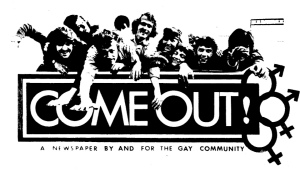
Just to give you a sense of its tone, the first lines of the first issue proclaimed, “COME OUT FOR FREEDOM! COME OUT NOW! POWER TO THE PEOPLE! GAY POWER TO GAY PEOPLE! COME OUT OF THE CLOSET BEFORE THE DOOR IS NAILED SHUT!” Before gay liberation (as scholars John D’Emilio and George Chauncey have shown), coming out meant entering into the gay community, but the new metaphor of the closet turned “coming out” into a political act—and demanded a total re-evaluation of the quietly queer lives many gay men and lesbians had lived before.
The New York Public Library also has a wonderful online exhibition commemorating the 40th anniversary of the Stonewall Riot, with some beautiful images culled from their extensive archives, like this one of two members of the Gay Activists Alliance.
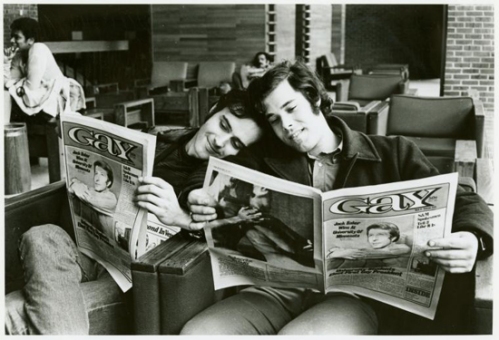
A quick subject search their digital image gallery reveals much, much more, including this photograph by Diana Davies of the 1971 Gay Pride march, almost as exciting for its vintage fashion as the banner “Women’s liberation is a lesbian plot.” Think about that next Women’s History Month.
![Christopher Street Liberation Day, June 20, 1971 [22]. Diana Davies, Stephen A. Schwarzman Building / Manuscripts and Archives Division, NYPL, Copyright Diana Davies, Digital ID: 1066141 Christopher Street Liberation Day, June 20, 1971 [22]. Diana Davies, Stephen A. Schwarzman Building / Manuscripts and Archives Division, NYPL, Copyright Diana Davies, Digital ID: 1066141](https://lazyscholar.files.wordpress.com/2009/10/index-1-php.jpeg?w=500)
That’s all for this week dear readers.
Historically yours,
Stephen
Read Full Post »

 But the best way to get into the Hollow’s Eve spirit for the die-hard Americanist: watching Disney’s still charming adaptation of Washington Irving’s”Legend of Sleepy Hollow,” with tunes sung by Bing Crosby himself. Tim Burton has nothing on this! Watch one of the highlights, “The Headless Horseman,” here.
But the best way to get into the Hollow’s Eve spirit for the die-hard Americanist: watching Disney’s still charming adaptation of Washington Irving’s”Legend of Sleepy Hollow,” with tunes sung by Bing Crosby himself. Tim Burton has nothing on this! Watch one of the highlights, “The Headless Horseman,” here.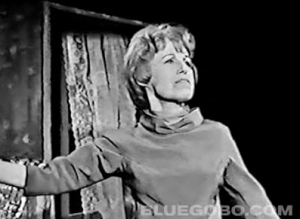

 If that leaves you wondering about the history of board games past, try digging through the rich archives of
If that leaves you wondering about the history of board games past, try digging through the rich archives of  And last but not least, some diversions from Parker Brothers. Sure, you can still find “Clue,” but what about “
And last but not least, some diversions from Parker Brothers. Sure, you can still find “Clue,” but what about “


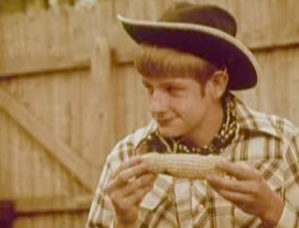
 So in honor of Sammy, I bring you today the marvelous
So in honor of Sammy, I bring you today the marvelous 













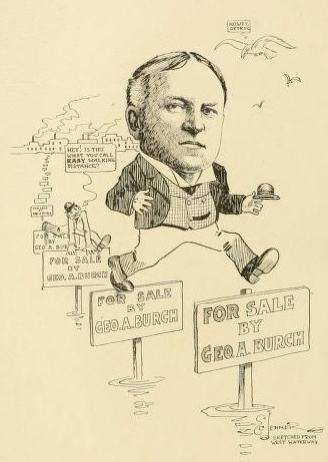



![Christopher Street Liberation Day, June 20, 1971 [22]. Diana Davies, Stephen A. Schwarzman Building / Manuscripts and Archives Division, NYPL, Copyright Diana Davies, Digital ID: 1066141 Christopher Street Liberation Day, June 20, 1971 [22]. Diana Davies, Stephen A. Schwarzman Building / Manuscripts and Archives Division, NYPL, Copyright Diana Davies, Digital ID: 1066141](https://lazyscholar.files.wordpress.com/2009/10/index-1-php.jpeg?w=500)